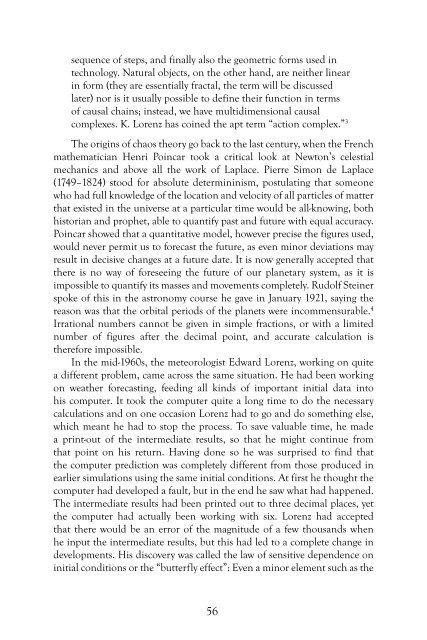When Healing Becomes Educating, Vol. 2 - Waldorf Research Institute
When Healing Becomes Educating, Vol. 2 - Waldorf Research Institute
When Healing Becomes Educating, Vol. 2 - Waldorf Research Institute
Create successful ePaper yourself
Turn your PDF publications into a flip-book with our unique Google optimized e-Paper software.
sequence of steps, and finally also the geometric forms used in<br />
technology. Natural objects, on the other hand, are neither linear<br />
in form (they are essentially fractal, the term will be discussed<br />
later) nor is it usually possible to define their function in terms<br />
of causal chains; instead, we have multidimensional causal<br />
complexes. K. Lorenz has coined the apt term “action complex.” 3<br />
The origins of chaos theory go back to the last century, when the French<br />
mathematician Henri Poincar took a critical look at Newton’s celestial<br />
mechanics and above all the work of Laplace. Pierre Simon de Laplace<br />
(1749–1824) stood for absolute determininism, postulating that someone<br />
who had full knowledge of the location and velocity of all particles of matter<br />
that existed in the universe at a particular time would be all-knowing, both<br />
historian and prophet, able to quantify past and future with equal accuracy.<br />
Poincar showed that a quantitative model, however precise the figures used,<br />
would never permit us to forecast the future, as even minor deviations may<br />
result in decisive changes at a future date. It is now generally accepted that<br />
there is no way of foreseeing the future of our planetary system, as it is<br />
impossible to quantify its masses and movements completely. Rudolf Steiner<br />
spoke of this in the astronomy course he gave in January 1921, saying the<br />
reason was that the orbital periods of the planets were incommensurable. 4<br />
Irrational numbers cannot be given in simple fractions, or with a limited<br />
number of figures after the decimal point, and accurate calculation is<br />
therefore impossible.<br />
In the mid-1960s, the meteorologist Edward Lorenz, working on quite<br />
a different problem, came across the same situation. He had been working<br />
on weather forecasting, feeding all kinds of important initial data into<br />
his computer. It took the computer quite a long time to do the necessary<br />
calculations and on one occasion Lorenz had to go and do something else,<br />
which meant he had to stop the process. To save valuable time, he made<br />
a print-out of the intermediate results, so that he might continue from<br />
that point on his return. Having done so he was surprised to find that<br />
the computer prediction was completely different from those produced in<br />
earlier simulations using the same initial conditions. At first he thought the<br />
computer had developed a fault, but in the end he saw what had happened.<br />
The intermediate results had been printed out to three decimal places, yet<br />
the computer had actually been working with six. Lorenz had accepted<br />
that there would be an error of the magnitude of a few thousands when<br />
he input the intermediate results, but this had led to a complete change in<br />
developments. His discovery was called the law of sensitive dependence on<br />
initial conditions or the “butterfly effect”: Even a minor element such as the<br />
56
















